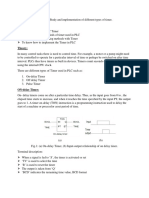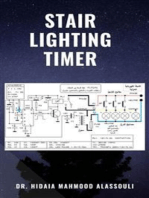Joozzer: Simatic Step7: Timer
Joozzer: Simatic Step7: Timer
Uploaded by
pandhuCopyright:
Available Formats
Joozzer: Simatic Step7: Timer
Joozzer: Simatic Step7: Timer
Uploaded by
pandhuOriginal Description:
Original Title
Copyright
Available Formats
Share this document
Did you find this document useful?
Is this content inappropriate?
Copyright:
Available Formats
Joozzer: Simatic Step7: Timer
Joozzer: Simatic Step7: Timer
Uploaded by
pandhuCopyright:
Available Formats
SIMATIC STEP7 : TIMER
OVERVIEW Timer is an instruction that waits a set amount of time before doing something. Sounds simple doesn't it. As always, different types of timers are available with different manufacturers. Here, however, are most of them: 1. On-Delay Timer This timer simply delays turning on. This timer will wait for a set of time before its association coils are energized. 2. Off-Delay Timer This timer works in opposite way of On-Delay Timer. This timer will wait for a set of time before its association coils are de-energized. 3. Retentive or Accumulating Timer This timer has a main different with the other two timers in retaining their current elapsed time. The other two will be reset and not complete timer duration when they are de-energized. Retentive Timer will retain its current elapsed time when it is de-energized and resuming the timer duration when it is energized. Simatic Step7 has five different types of timers. It can be pre-loaded using either of the following formats: 1. W#16#wxyz - Where w = time base (time interval or resolution). - Where xyz = the time value in binary coded decimal format. 2. S5T#aH_bM_cS-dMS - Where H = hours, M = minutes, S = seconds, MS = milliseconds, and a, b, c, d is defined by user. The maximum value can be entered is 9990 seconds or 2H_46M_30S.
joozzer
Page 1 of 4
1. S_PULSE S_PULSE timer will be energized as long as signal state at input S is active or 1. A signal change is always necessary in order to enable a timer. If signal state change from 1 to 0 before the time interval has elapsed, the timer will be stopped. In this case the signal state at output Q is 0.
3. S_ODT S_ODT (On-Delay Timer) starts specified timer if there is a signal change from 0 to 1 at input S. the timer will be kept running for the time interval as long as signal state at input S is 1. Signal state at output Q is 1 if time interval of the timer is elapsed without error and signal state at input S is still 1. When the signal state at input changes to 0 while the timer is running, the timer is stopped.
2. S_PEXT This timer runs for the preset time interval specified even if the signal state at input S change from 1 to 0 before the time interval has elapsed. The signal state at output Q is 1 as long as the timer is running. The timer will be restarted with the preset time value if the signal state at input S changes from 0 to 1 while timer is running.
4. S_ODTS A Retentive On-Delay Timer that starts specified time interval if there is a trigger at input S. Behave like S_ODT but without regarding to the signal state at input. In other words, timer will continue running even the signal state at input changes from 1 to 0. Signal state at the output Q is 1 when time interval has elapsed. Timer will be restarted with specified time if signal state at input changes from 0 to 1 while timer is running.
joozzer
Page 2 of 4
T11 is a retentive pulse timer and Q7.1 is an output coil
5. S_OFFDT S_OFFDT (Off-Delay Timer) starts specified timer if there is a signal change from 1 to 0 at input S. the signal state at output Q is 1 if signal state at S is 1 or while Timer T10 and T11 have 5 timer is running. seconds preset time interval. When The timer is reset when the signal I7.0 is energized (green indicates it state at input S changes from 0 is energized), it triggers T10 and T11 to 1. to work. The two timers will work for 5 seconds.
EXAMPLES As It was described earlier, a retentive timer can retain its current elapsed time and complete its specified time interval when it was energized again. An example below can describe how a retentive timer works compare to a non retentive timer. - I7.0 works as a trigger for two timers. - T10 is a non retentive pulse timer and Q7.0 is an output coil.
Output coil Q7.0 and Q7.1 are energized as long as the two timers are running. If I7.0 is de-energized while T10 is running, T10 will stop running. But, that will not happen for T11. T11 will continue running and complete its specified time interval even if I7.0 de-energized.
joozzer
Page 3 of 4
Here is timing diagram for all available timers in Step7.
Here is a network to see timing diagram of all available timers in Step7.
Knowing their function well will help to choose the right timers for an application.
joozzer
Page 4 of 4
You might also like
- Assignment 1: 11520G Data Capture and PreparationsDocument7 pagesAssignment 1: 11520G Data Capture and PreparationsagamdeepNo ratings yet
- General Semiconductor Products CatalogDocument695 pagesGeneral Semiconductor Products CatalogEdd Whatley50% (2)
- Lesson 1-The Formation of The UniverseDocument41 pagesLesson 1-The Formation of The UniverseRaymond Escuzar100% (2)
- Intuitive Control Algorithm Development of 4WIS/4WID Using A SpaceMouseDocument46 pagesIntuitive Control Algorithm Development of 4WIS/4WID Using A SpaceMouseTyler KimNo ratings yet
- GU620AGenset Controller Operation ManualDocument66 pagesGU620AGenset Controller Operation ManualSumadi NgampelNo ratings yet
- GuardiumDocument2 pagesGuardiummamoutoubNo ratings yet
- MOSCAD L Owners Manual PDFDocument126 pagesMOSCAD L Owners Manual PDFJesús Valdés100% (1)
- Sierra 303B Frequency Selective Levelmeter Operation Manual (SOM-303B), January 1974.Document25 pagesSierra 303B Frequency Selective Levelmeter Operation Manual (SOM-303B), January 1974.Bob Laughlin, KWØRL100% (2)
- Data Sheet (English) - 8036 Industrial ControlsDocument44 pagesData Sheet (English) - 8036 Industrial ControlsNabil ShaukatNo ratings yet
- Getting Started On The AT91SAM7X-EK PDFDocument16 pagesGetting Started On The AT91SAM7X-EK PDFJohn DerteanoNo ratings yet
- OMRON To Vijeo CitectDocument6 pagesOMRON To Vijeo CitectArie Dwi CahyonoNo ratings yet
- Timers On The ATmega168 - 328 - QEEWikiDocument9 pagesTimers On The ATmega168 - 328 - QEEWikiRalphEdwardMagoNo ratings yet
- ProgrammingDocument12 pagesProgrammingmile1966No ratings yet
- Microprocessor Basic ProgrammingDocument132 pagesMicroprocessor Basic Programmingersimohit100% (1)
- Masterplug Electronic Timer Instruction (E)Document1 pageMasterplug Electronic Timer Instruction (E)desNo ratings yet
- Ejercicios Resueltos de Máquinas TérmicasDocument11 pagesEjercicios Resueltos de Máquinas TérmicasJosepBravoDávilaNo ratings yet
- Datasheets Archives Electronic Circuit ProjectsDocument8 pagesDatasheets Archives Electronic Circuit Projectsgeorge1No ratings yet
- Eco Rich Ehu Series Instruction Manual Se04430-3Document47 pagesEco Rich Ehu Series Instruction Manual Se04430-3александр ЗавьяловNo ratings yet
- AC Servo Motors - BSM SeriesDocument96 pagesAC Servo Motors - BSM SeriesIrving Alexander Morales PérezNo ratings yet
- Separately Excited DC Motor - Electronic Components (Systems) - Electronics Tutorial PDFDocument3 pagesSeparately Excited DC Motor - Electronic Components (Systems) - Electronics Tutorial PDFSaurav kumarNo ratings yet
- ProgrammingDocument10 pagesProgrammingmusicalblizzardNo ratings yet
- HP LaserJet 4L - 4P Service ManualDocument306 pagesHP LaserJet 4L - 4P Service ManualimakingtxNo ratings yet
- Power Electronics Projects 2011@PELS TECH-SathyamangalamDocument3 pagesPower Electronics Projects 2011@PELS TECH-SathyamangalamPower Electronics TechnologyNo ratings yet
- OpenTx FrSky Manual 130822Document42 pagesOpenTx FrSky Manual 130822gepapaNo ratings yet
- Chapter 2 TransformersDocument3 pagesChapter 2 TransformersSuktara-Drubatara TaritNo ratings yet
- Graupner MX 16s ENDocument116 pagesGraupner MX 16s ENsavagel4No ratings yet
- The Generic STM32F103 Pinout DiagramDocument1 pageThe Generic STM32F103 Pinout DiagramHamdani Tock100% (1)
- Electronic Components-EDM PDFDocument526 pagesElectronic Components-EDM PDFEduardo J. KwiecienNo ratings yet
- 555 Timer Ic: Project ReportDocument10 pages555 Timer Ic: Project ReportHarshada HalarnkarNo ratings yet
- Humidity & Temperature Controller Pro.Document41 pagesHumidity & Temperature Controller Pro.Amir WagdarikarNo ratings yet
- PIC Single-Chip 4-Digit 99-Minute Timer: DiscussionDocument4 pagesPIC Single-Chip 4-Digit 99-Minute Timer: Discussionravikiran1955No ratings yet
- Self Balancing RobotDocument5 pagesSelf Balancing RobotMuhammadHarisNo ratings yet
- Hamamatsu Photomultiplier TubeDocument120 pagesHamamatsu Photomultiplier TubeMuhammad UzairNo ratings yet
- Siemens: SONOLINE SI-400 Imaging SystemDocument278 pagesSiemens: SONOLINE SI-400 Imaging SystemZakaria ZebbicheNo ratings yet
- Power Electronics and DrivesDocument3 pagesPower Electronics and DrivesAsprilla Mangombe100% (1)
- Datasheet SKHI 22A PDFDocument12 pagesDatasheet SKHI 22A PDFGlauber GoncalvesNo ratings yet
- Zanussi ls9p MaDocument2 pagesZanussi ls9p MaМикола Романенко50% (2)
- Man FXM FKM Motors PDFDocument166 pagesMan FXM FKM Motors PDFPaun AlNo ratings yet
- Microcontroller At89c52Document3 pagesMicrocontroller At89c52chaumathurNo ratings yet
- Torque of ThreePhase Induction Motor ExplainedDocument2 pagesTorque of ThreePhase Induction Motor Explainedsaga2000cnNo ratings yet
- Operating Parameter Programming Module Wam 1019 Indramat Manual PDFDocument11 pagesOperating Parameter Programming Module Wam 1019 Indramat Manual PDFremus popescuNo ratings yet
- T6990 Depliant ENG PDFDocument2 pagesT6990 Depliant ENG PDFForTestNo ratings yet
- Solar-Powered Battery Charging With Highly Efficient Buck ConverterDocument20 pagesSolar-Powered Battery Charging With Highly Efficient Buck ConverterSusanNo ratings yet
- BeagleBoneBlack TutorialsDocument24 pagesBeagleBoneBlack Tutorialstuyen1989100% (1)
- RealWear HMT-1 Release 10.5 User Guide EN v1 20191021Document84 pagesRealWear HMT-1 Release 10.5 User Guide EN v1 20191021Top5 In VietnamNo ratings yet
- Application Note For FC 100, FC 200 and FC 300 Motor Protection ENG - MN900102Document2 pagesApplication Note For FC 100, FC 200 and FC 300 Motor Protection ENG - MN900102Carlos Alirio Vera ANo ratings yet
- Electrical Schematic: Shutdown SDocument6 pagesElectrical Schematic: Shutdown SAnton Mariastono100% (1)
- Electronic ComponentsDocument411 pagesElectronic ComponentsChristopher George0% (1)
- PG DV250Document14 pagesPG DV250admirduNo ratings yet
- Codesys BeijerDocument31 pagesCodesys BeijerpedroNo ratings yet
- 810d Configuration PDFDocument120 pages810d Configuration PDFSergio Trujillo Cerro100% (1)
- HF-320 스미토모 인바타 메뉴얼 PDFDocument259 pagesHF-320 스미토모 인바타 메뉴얼 PDFAmith PrasannaNo ratings yet
- CML720 Light Currtain PDFDocument197 pagesCML720 Light Currtain PDFTruong NguyenNo ratings yet
- MQ135 (Ver1.4) - ManualDocument7 pagesMQ135 (Ver1.4) - ManualPavankumar VijapurNo ratings yet
- Ad44 2Document22 pagesAd44 2Mathe ZsoltNo ratings yet
- Bobinarea TransformatorDocument88 pagesBobinarea TransformatorIonNo ratings yet
- TimersDocument9 pagesTimersFelipe OrtizNo ratings yet
- PLC Report TimerDocument5 pagesPLC Report TimersadmanNo ratings yet
- C S O I F: Hapter IX Ther Mportant UnctionsDocument30 pagesC S O I F: Hapter IX Ther Mportant UnctionsMohamed OmarNo ratings yet
- TimersDocument4 pagesTimersMuhammad PandorNo ratings yet
- S7 KonverterDocument328 pagesS7 KonverterpandhuNo ratings yet
- SCL LanguageDocument394 pagesSCL LanguageMarius Nicusor PopescuNo ratings yet
- Siemens WinCC Flexible Training CourseDocument2 pagesSiemens WinCC Flexible Training Coursepandhu100% (1)
- STD NDP 2212Document202 pagesSTD NDP 2212pandhuNo ratings yet
- 09 FC FBDocument24 pages09 FC FBpandhuNo ratings yet
- Getting Started: Creating A TCP-IP Protocol Client ApplicationDocument12 pagesGetting Started: Creating A TCP-IP Protocol Client ApplicationpandhuNo ratings yet
- D7sys Funktion BDocument530 pagesD7sys Funktion BpandhuNo ratings yet
- Code Builder - English ManualDocument190 pagesCode Builder - English ManualpandhuNo ratings yet
- Protocols - English ManualDocument186 pagesProtocols - English ManualpandhuNo ratings yet
- Alcatel Omnipcx Enterprise: VPN OverflowDocument42 pagesAlcatel Omnipcx Enterprise: VPN OverflowAriel BecerraNo ratings yet
- Unikrn Bermuda LTD Terms of Token Sale Last Updated: September 22, 2017Document20 pagesUnikrn Bermuda LTD Terms of Token Sale Last Updated: September 22, 2017Rony PatahNo ratings yet
- Share KhanDocument10 pagesShare KhangautammandalNo ratings yet
- SVC Project Document-FINAL - Team 2Document5 pagesSVC Project Document-FINAL - Team 2taylorNo ratings yet
- Consolidated Statement: Your Financial StatusDocument4 pagesConsolidated Statement: Your Financial StatusAnonymous hzew9wNo ratings yet
- mmf2 Develop HelpDocument187 pagesmmf2 Develop HelpStelios LafazanisNo ratings yet
- AIS - Written ReportDocument10 pagesAIS - Written ReportMohammad Nowaiser MaruhomNo ratings yet
- Parametric Design of Sailing Hull Shapes: Antonio MancusoDocument13 pagesParametric Design of Sailing Hull Shapes: Antonio MancusolavrikNo ratings yet
- Machine Profiles: D10R Track-Type TractorsDocument5 pagesMachine Profiles: D10R Track-Type TractorsJavier Pagan TorresNo ratings yet
- FDocument37 pagesFMartial SOMENo ratings yet
- 8.4 Polar Bonds NewDocument25 pages8.4 Polar Bonds Newswailemnouf7No ratings yet
- EuphoriaDocument2 pagesEuphoriaAmit MalhotraNo ratings yet
- PresentationsDocument1 pagePresentationsMadina SaparbaevaNo ratings yet
- InnAccel - VapCare - NH Covid StudyDocument15 pagesInnAccel - VapCare - NH Covid Studyemailtrinaya30No ratings yet
- Rulebook: in Association WithDocument20 pagesRulebook: in Association With2050101 A YUVRAJNo ratings yet
- Electrical Layout: SpecificationDocument1 pageElectrical Layout: SpecificationREX AMPONGANNo ratings yet
- Permutations and Combinations: (IIT JEE - 1985 - 5 Marks)Document2 pagesPermutations and Combinations: (IIT JEE - 1985 - 5 Marks)Vatsal PatelNo ratings yet
- Surface Diagnostics in TribologyDocument13 pagesSurface Diagnostics in TribologyDersein SaraozNo ratings yet
- I. Context and Rationale: Review of Related LiteratureDocument3 pagesI. Context and Rationale: Review of Related Literaturecarmena b. orisNo ratings yet
- Form 13: Financial Statement (Support Claims) Sworn/affirmed atDocument6 pagesForm 13: Financial Statement (Support Claims) Sworn/affirmed atmashta04No ratings yet
- 136 Yos Online Yabanci Uyruklu Ogrenci Sinavi TR YosDocument5 pages136 Yos Online Yabanci Uyruklu Ogrenci Sinavi TR Yosusmanmughal127790No ratings yet
- Chapter 0. Prerequisites 0.3: Sum and Product Notation: Slides (Google Drive) Video (Youtube)Document5 pagesChapter 0. Prerequisites 0.3: Sum and Product Notation: Slides (Google Drive) Video (Youtube)HMXNo ratings yet
- Trek Volunteer Info Packet 2015Document6 pagesTrek Volunteer Info Packet 2015api-275865446No ratings yet
- Mikroc Dspic ManualDocument508 pagesMikroc Dspic ManualBui Huu BinhNo ratings yet
- Structures - Iii: Earthquake Behavior of BuildingsDocument24 pagesStructures - Iii: Earthquake Behavior of Buildingsabhivyakti kushwahaNo ratings yet
- ZF6HP26 Bi-Metal Bushing Kit - Alto 183625BDocument1 pageZF6HP26 Bi-Metal Bushing Kit - Alto 183625Bporter1980No ratings yet
- Determining The Scope of The Quality Management SystemDocument6 pagesDetermining The Scope of The Quality Management SystemNaeemNo ratings yet
- JASO 4 Stroke Motorcycle Engine Oil Code List 2014Document35 pagesJASO 4 Stroke Motorcycle Engine Oil Code List 20146zjptk1okNo ratings yet
- Mission Green Sept 2017Document1 pageMission Green Sept 2017Robert OkandaNo ratings yet


































































































